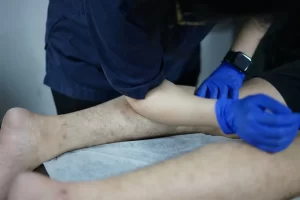Wound healing is a complex biological process that sets the pace for recovery from injuries, surgeries, and chronic conditions. Recent advances in wound healing studies are transforming how we understand, treat, and accelerate the healing process. Innovative therapies and groundbreaking research tools are just some of these developments that hold immense potential for improving patient outcomes and quality of life.
This article explores the latest advancements in wound healing studies, shedding light on new technologies, therapies, and insights shaping the future of care.
Key Takeaways
- The field of wound healing research is advancing rapidly, offering new hope for patients.
- Cutting-edge biomaterials, regenerative medicine, AI-powered diagnostics, and innovative drug delivery systems are some of the breakthroughs transforming the way wounds are treated.
Table of Contents
Partner With IBEX for Expert Wound Healing Innovation Preclinical Research
1. Advanced Biomaterials for Wound Healing
One of the most significant breakthroughs in wound healing research is the development of advanced biomaterials. These materials are engineered to support the healing process by creating optimal environments for tissue regeneration.
- Hydrogel Dressings — Hydrogels provide moisture to the wound, promoting faster healing and reducing the risk of infection.
- Electrospun Nanofibers — These structures mimic the extracellular matrix, providing a scaffold for cell growth and tissue repair.
- Bioactive Wound Dressing — Infused with growth factors, peptides, or antimicrobial agents, these dressings actively accelerate healing.
2. Cellular and Molecular Insights
Advances in molecular biology have deepened our understanding of the wound healing process, particularly the roles of cells and signaling pathways.
Key discoveries include:
- Growth Factors — Studies are exploring the use of growth factors like VEGF (vascular endothelial growth factor) and EGF (epidermal growth factor) to stimulate cell proliferation and angiogenesis.
- Stem Cells — Research into mesenchymal stem cells (MSCs) and induced pluripotent stem cells (iPSCs) show promise for regenerating damaged tissues.
- Inflammatory Pathways — Understanding the balance between pro-inflammatory and anti-inflammatory signals is helping researchers design therapies to minimize chronic inflammation in non-healing wounds.
3. Innovations in Drug Delivery Systems
Effective drug delivery is essential for treating wounds, particularly those with infections or complications. New delivery systems are improving how therapeutic agents are administered:
- Nanoparticle Delivery — Nanoparticles enable the targeted release of drugs directly to wound sites, reducing systemic side effects.
- Smart Dressings — These dressings respond to environmental changes, such as pH or temperature, to release drugs only when needed.
- Microneedle Patches — Microneedles deliver growth factors, stem cells, or antibiotics directly into deeper layers of the wound, enhancing effectiveness.
4. Regenerative Medicine and Tissue Engineering
Regenerative medicine is reshaping how wounds are treated by focusing on repairing and replacing damaged tissues. Key advancements include:
- 3D Bioprinting — This technology allows researchers to create customized skin grafts with precise structures that mimic natural tissue.
- Engineered Skin Substitutes — Products like bioengineered skin, made from natural or synthetic materials, are being used to treat burns and chronic wounds.
- Extracellular Vesicles — Derived from stem cells, these vesicles carry healing signals to promote tissue regeneration.
5. Digital Technologies and Artificial Intelligence (AI)
Digital technologies are playing an increasing role in wound healing research and care:
- AI-Powered Diagnostics — AI algorithms analyze wound images to assess healing progress and recommend treatment adjustments.
- Wearable Sensors — These devices monitor wound conditions, such as moisture levels or infection markers, in real time.
- Telemedicine — Remote monitoring allows clinicians to track wound healing and provide guidance without requiring in-person visits.
6. Breakthroughs in Chronic Wound Treatment
Chronic wounds, such as diabetic ulcers or pressure sores, remain a significant challenge in healthcare. New therapies addressing these persistent issues include:
- Oxygen Therapy — Innovations in oxygen delivery systems, such as topical oxygen devices, improve healing in ischemic wounds.
- Biofilm Management — Targeting bacterial biofilms with novel antimicrobial agents and enzymes is enhancing infection control.
- Gene Therapy — Gene-editing techniques like CRISPR are being explored to modify wound environments and promote faster healing.
7. Preclinical and Clinical Research Advances
Robust preclinical and clinical studies are driving the translation of laboratory discoveries into real-world applications:
- Animal Models — Improved models that mimic human wound healing are providing better insights into therapy effectiveness.
- In Vitro Studies — 3D wound models and organ-on-chip technologies allow researchers to study healing dynamics in controlled environments.
- Clinical Trials — Large-scale trials are validating the safety and efficacy of new therapies, ensuring they meet regulatory standards before reaching patients.
Partner With IBEX for Expert Wound Healing Innovation Preclinical Research
IBEX offers unmatched expertise in wound healing studies including biomaterials, regenerative medicine, and drug delivery. Leverage our advanced in vitro and in vivo wound healing models and proven track record of accelerating product development timelines to give your project the jumpstart it deserves. Contact us today to learn more.






